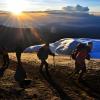Can You Climb Kilimanjaro in a Day?
Climbing Kilimanjaro in a single day is not feasible or recommended due to its considerable height and the risk of altitude sickness. Mount Kilimanjaro is the highest peak in Africa, and a gradual ascent is crucial to allow your body to acclimatize to the decreasing oxygen levels at higher altitudes.
Standard climbing routes on Kilimanjaro typically take several days, ranging from 5 to 9 days, depending on the chosen route. Rushing the ascent significantly increases the risk of altitude-related issues, which can range from mild symptoms like headaches and nausea to more severe conditions that may require immediate descent.
Climbing Mount Kilimanjaro is a challenging but rewarding adventure. Here are some tips to help you prepare and make the most of your Kilimanjaro climb:
-
Choose the Right Route
Kilimanjaro offers various routes with different difficulty levels and scenery. Research and choose a route that suits your fitness level and preferences. Popular routes include Machame, Marangu, Lemosho, and Rongai.
-
Acclimatization is Key
Altitude sickness is a concern on Kilimanjaro. Opt for an itinerary that includes gradual ascent and rest days for acclimatization. Climbing too quickly increases the risk of altitude-related issues.
-
Physical Preparation
Train for the climb by incorporating cardiovascular exercises like hiking, walking, and running. Strengthen your legs and core to handle the demanding terrain.
-
Gear Check
Ensure you have the necessary gear, including good-quality hiking boots, warm clothing, a comfortable backpack, and a reliable sleeping bag. Consult your tour operator's equipment list.
-
Hydration and Nutrition
Stay hydrated by drinking plenty of water throughout the climb. Carry a reusable water bottle. Consume a balanced diet to maintain energy levels.
-
Mental Preparation
Climbing Kilimanjaro is physically and mentally challenging. Be mentally prepared for the varying conditions, long hikes, and potential discomfort. A positive mindset is crucial.
-
Choose a Reputable Tour Operator
Research and select a reputable tour operator with experienced guides. Read reviews, ask for recommendations, and ensure they prioritize safety and responsible tourism.
-
Travel Insurance
Obtain comprehensive travel insurance that covers high-altitude trekking and potential emergencies. Confirm the specifics with your insurance provider.
-
Pack Wisely
Pack efficiently and follow your tour operator's packing list. Include essentials like sunscreen, a hat, sunglasses, and a first aid kit. Minimize unnecessary items to lighten your load.
-
Follow the Leave No Trace Principles
Respect the environment by following Leave No Trace principles. Stay on designated trails, pack out all waste, and adhere to guidelines set by park authorities.
-
Listen to Your Guides
Follow the guidance of your experienced guides. They are familiar with the mountain, its challenges, and safety protocols. Communicate openly with them about how you're feeling.
-
Celebrate the Journey
Enjoy the breathtaking landscapes and celebrate the journey. Kilimanjaro offers unique ecosystems and stunning views. Take time to appreciate the experience.
Remember, safety is the top priority. Adequate preparation, a positive mindset, and responsible trekking practices will contribute to a successful and enjoyable climb of Mount Kilimanjaro.
It's crucial to follow the recommended climbing itineraries provided by experienced guides and tour operators to ensure a safe and enjoyable ascent. Rushing the climb without proper acclimatization can pose serious health risks and diminish the overall experience of reaching the summit.




